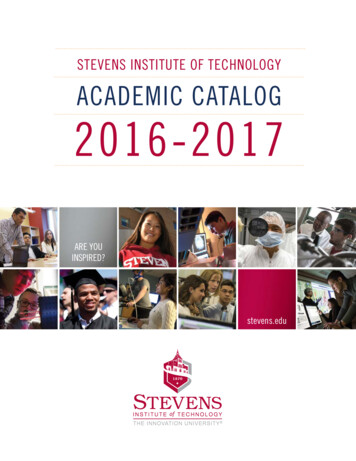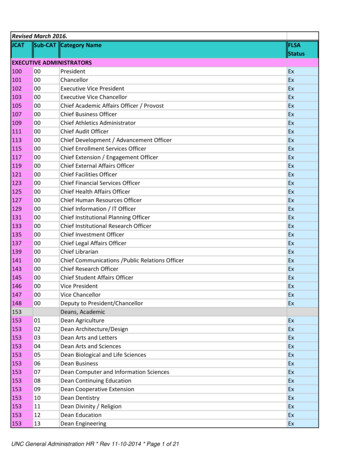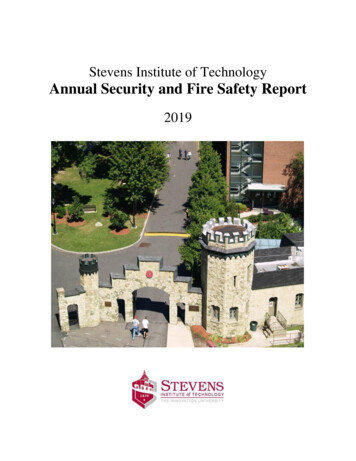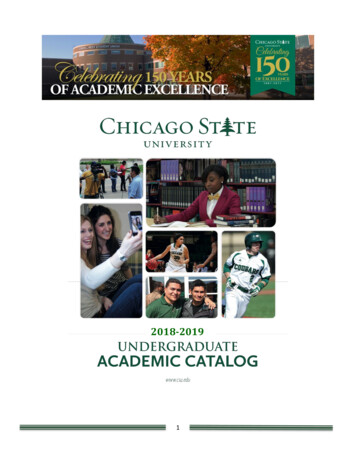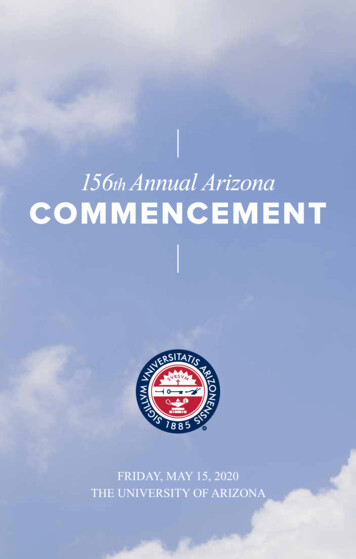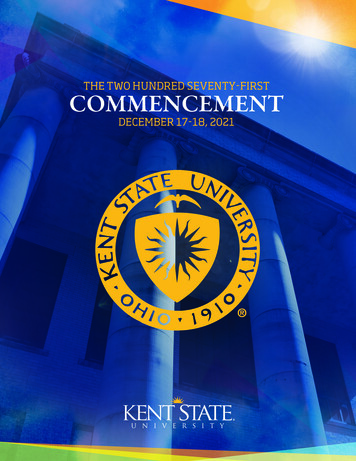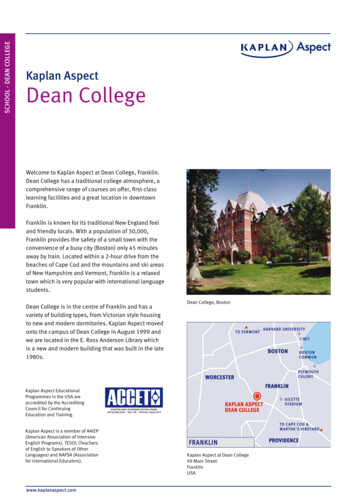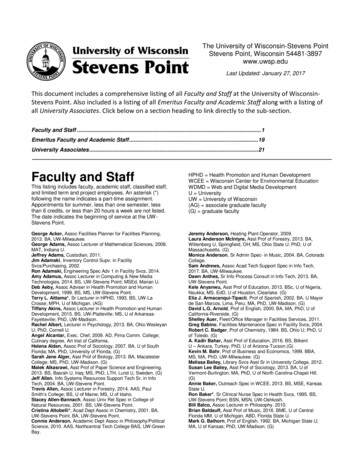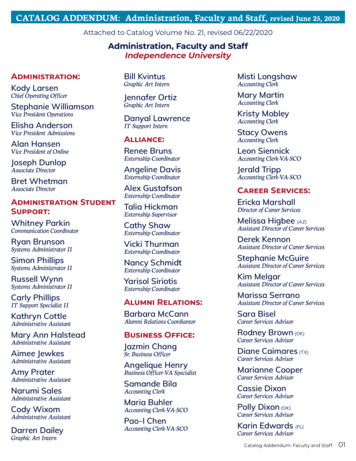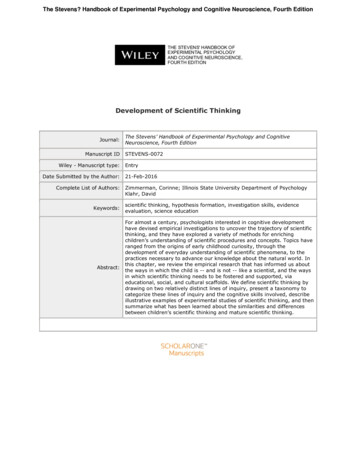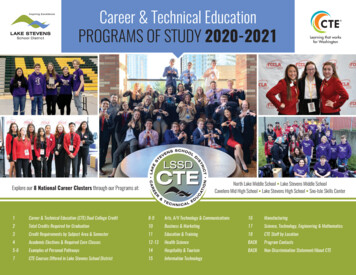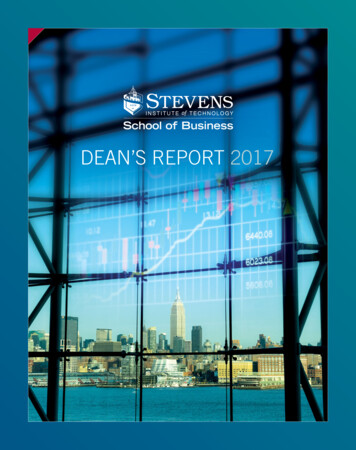
Transcription
DEAN’S REPORT 2017
Our missionWe impact industry, academia and societythrough business education and research in atechnology-driven economy.Our visionTo be a leading business school widely recognizedfor superior technology-focused and student-centriceducational programs and research.2461014161820D ea n ’s Me s s a g eAchievement sUndergraduateG r ad uat eFinanceR es ear chN ew Fa c u l t yR e a l Wo r l d 1
D E A N ’ S ME S S A G EStevens means businessIn 2012, soon after my arrival at Stevens, the community of the Howe School of Technology Managementcollaborated to develop a strategic plan for the next five years. The result of this exercise was an ambitiousplan that called for the transformation of the school to an accredited School of Business, while at the sametime achieving high goals for quality, growth and impact.Five years later, everyone realizes an extraordinary change has taken place. New undergraduate businessmajors and new graduate programs have successfully been launched; enrollments have increased significantly,while the quality of the incoming classes improved as well; new research-active faculty have been pursuedand hired in key business areas; research and research impact have grown; the student experience hasimproved; our graduate programs have appeared in national rankings; and much more. In May 2015, theschool was granted accreditation by AACSB, and was formally renamed the School of Business at Stevens.We continue strong. With innovative programs like Quantitative Finance and Accounting & Analytics atthe undergraduate level, and Business Intelligence & Analytics and Enterprise Project Management at thegraduate level, we continue to build on the technology and analytics ecosystem of Stevens in order to offerup-to-date programs and cutting-edge research, integrating business principles and best practices withtechnology innovations to achieve improved processes and optimized decisions.Even though our results are impressive, there is still much to be accomplished. A new strategic plan isbeing developed for the next phase of the school’s development, calling for more activities to enrich thestudent experience, more top-notch faculty to conduct breakthrough research, new innovative programsthat reflect the changes in our society, enhanced infrastructure like labs and student spaces, and so on.This report presents the changes that have happened in the last five years, as well as some of what wecall the “Stevens DNA” that characterizes most of our decisions. I welcome you to share in some of oursuccesses as we continue our journey to become a leader in technology-driven business education andresearch, and show how Stevens means business.Sincerely,Dr. Gregory PrastacosDean and ProfessorSchool of BusinessStevens Institute of Technology2 Ste v e n s Sc h o ol of Business Dean’s Repor t 201 7
De a n ’s Me s s a g eAchievement sUndergraduateG r ad uat eFinanceR es ear chN ew Fa c u l t yR e a l Wo r l d 3
A C H I E V E ME N TSBuilding a business school at StevensThe 2012-17 School of Business strategic plan, which was acclaimed by the AACSB review team for its completeness and exemplaryexecution, was fully aligned with the university’s strategic plan and identified four key pillars for the school to address:QUALITY. We will stand for quality in all that we do.QUALITY IDENTITYIDENTITY. We will be a unique business school with technology at our core.IMPACTGROWTH. Our undergraduate and graduate student body and faculty will be larger and more diverse.GROWTHIMPACT. We will have impact throughout the world.Here are five key achievements:AACSB accreditationTo address the objective of Quality, the School of Business made AACSB accreditation a top priority. A major mobilization of facultyand staff began in 2012, and included revamping curricula, hiring research-active faculty, setting up academic processes, installingcontinuous improvement mechanisms, aligning the mission and vision of the school with AACSB International standards, and muchmore. Stevens earned accreditation in May 2015, the first non-STEM accreditation in Stevens’ 140-year history.RebrandingIn May 2015, following the creation of many new business majors and graduate programs, the Howe School of Technology Managementbecame the School of Business. The transition recognized the changing need in the marketplace for graduates of technology-infusedbusiness programs able to think quantitatively about strategy, decision-making and entrepreneurship.Remarkable growthThe school’s growth over the past five years has been phenomenal, and encompasses every category — from number of programsoffered, number of applications received, number of enrollments, student qualifications, faculty size, research output and impact,research funding, corporate outreach, and revenue. At the same time, a number of diversity metrics improved.Research impactStarting in 2012, the School of Business has placed greater emphasis on both publication in top journals and dissemination offaculty research. Since then, there has been remarkable growth in the number of papers published in both the prestigious FT 50 listof journals and in journals belonging to the top two categories of the ABS list (ABS3/ABS4). The number of citations has dramaticallyincreased, while research funding from prestigious sources, like the National Science Foundation, has grown.Corporate connectionsTo further its impact on industry, the School of Business has been strengthening its ties to businesses. The school launched a numberof new onsite corporate programs; developed a Field Consulting Program in collaboration with industry; and established advisoryboards packed with leaders in industry. In addition, the school revitalized its key industry partnerships, the Stevens Alliance forInnovation and Leadership (SAIL) and the Consortium for Corporate Entrepreneurship (CCE).4 Ste v e n s Sc h o ol of Business Dean’s Repor t 201 7
BY TH E N U M B E R S8#9#Master’s in Managementin U.S.(TFE Times, 2016)100Master’s in BusinessAnalytics in U.S.(TFE Times, 2016)%Placement Rate (Class of 2016)120#Online MBAin New JerseyHigher Starting Salariesthan U.S. Average(U.S. News & World Report, 2016)33#(Class of 2015)Online Non-MBABusiness Programsin the U.S.35For Valuein the U.S.(Economist, 2015)De a n ’s Me s s a g eAchievement s17#For MostEntrepreneurialSchools in America(Affordable Schools, 2015)3,000 Job OpportunitiesPosted forStevens StudentsUndergraduateFor HighestMedian Earnings(Georgetown University Center onEducation and the Workforce, 2016)(U.S. News & World Report, 2016)#5#%G r ad uat eFinance12#For 20-year Returnon Investment(PayScale, 2016)R es ear chN ew Fa c u l t yR e a l Wo r l d 5
U N D E RG R A D U AT EMajor growthA critical component of the school’s transformation and growth effort wasto enrich its program offerings, with new undergraduate business majors toattract additional students interested in a broad suite of specialties. Six newmajors have been launched in the last five years, in Accounting & Analytics,Economics, Finance, Information Systems, Management and Marketing.These new majors complement the already successful programs in Business& Technology and Quantitative Finance, and bring the total number ofundergraduate majors offered from two to eight.737The impact of the diversification and expansion of the undergraduate programhas brought in record numbers of applicants, while raising significantly thequality standards of the incoming L ENROLLMENT6 Ste v e n s Sc h o ol of Business Dean’s Repor t 20172012APPLICANTS2016NEW ENROLLMENTS20122012201320132014201420152015SAT AVERAGEINCOMING CLASS20162016
Undergraduate majorsAccounting & Analytics*Business & TechnologyEconomics*Finance*Information Systems*Management*Marketing*Quantitative Finance* New majors added since 2012Incredible placement,solid returnsThe placement rate for the School of Business could not be stronger. Forthe Class of 2016, 100 percent of undergraduates were employed in thefield of their choice or accepted into graduate school within six months ofcommencement, a testament to the practical focus and analytical emphasisof Stevens business classes.The value of a Stevens education also is felt through internships. Recruitersknow Stevens students are able to apply their classroom lessons withoutlengthy orientation periods, so they draw challenging, high-visibility projectsfrom the beginning. Ninety percent of students do at least one internship, andmany take on more than one.MEET: GENEVIEVE FINN ’17Genevieve Finn has had some incredible internships with JPMorgan Chase, buther passion is in running her nonprofit Genevieve’s Crutches, which collectsused crutches, decorates them and donates them to disabled veterans.Genevieve says her Stevens classes made her comfortable talking to managersas an intern: “The interviewers asked me in detail about my classes, and howI could apply them at work — and that was probably the easiest question theycould have asked, because all the classes here at Stevens emphasize realworld application.”D ea n ’s Me s s a g eAchievement sUndergraduateG r ad uat eFinanceR es ear chN ew Fa c u l t yR e a l Wo r l d 7
U N D E RG R A D U AT E88%Increase in total undergraduateenrollment, 2012-16108 pointsIncrease in average SAT score forincoming class, 2012-16Beyond the classroom90%Along with the curricular enhancements created through the new majors, theNumber of business students whocomplete at least one internshipSchool of Business has developed additional opportunities that allow studentsto further explore their potential. Students have the opportunity to get involvedwith many student clubs, participate in international study trips or semestersabroad, attend lectures from thought leaders, participate in competitions,develop their entrepreneurial passions, or just enjoy nearby New York City.67,600 Student competitionsBusiness students at Stevens have a healthy appetite for competition, and theyAverage starting salary forgraduates of the Class of 2016have a track record of strong performance. Student teams have performed wellat competitions in the past few years. Stevens is a regular finalist in the CMEGroup’s annual Trading Challenge, which features hundreds of student teamsfrom dozens of countries. A Stevens undergraduate team also took top honorsin the 2016 Ten Plus Supply Chain Case Dual Challenge, which featuredcompetitors like Maryland, Syracuse, Northeasternand Penn State. Business students also played avital support role in planning and soliciting andtracking donations for the construction of theSURE House, Stevens’ winning entry into the U.S.Department of Energy’s Solar Decathlon.8 Ste v e n s Sc h o ol of Business Dean’s Repor t 201 7151%Increase in applicants to theundergraduate programs, 2012-16
Academic distinctionThe School of Business in 2016 welcomed its first class of high achieversinto its chapter of Beta Gamma Sigma, the business school honor society.Only students with the best grades are invited to become members of thesociety, which is considered the highest honor at an AACSB-accredited school.Membership in Beta Gamma Sigma provides many benefits and networkingopportunities to its members.Real-world perspectiveBusiness students are able to hear from some of the most exciting mindsin the corporate world today through a variety of campus lecture series. ThePresident’s Distinguished Lecture Series has welcomed such luminaries asSharmin Mossavar-Rahmani, the chief investment officer of Goldman Sachs;Top recruitersNorman Augustine, former CEO of Lockheed Martin; and Dr. Craig Barrett,The marketplace recognizes the value of aformer president, CEO and chairman of Intel. Other lecture series, such asStevens education. PayScale’s recent reports allthe Provost’s Lecture Series and the Heath Lecture Series, specific to thedemonstrate the impressive return on investmentSchool of Business, have welcomed former ADP CEO Josh Weston; MorrisStevens offers its graduates. For 2016, PayScaleTanenbaum, executive vice president of AT&T; Lori Traweek, CEO of Americanranked Stevens No. 12 in the country for 20-yearGas Association; Linda S. Sanford, senior vice president of enterprisenet return on investment, while it ranked Stevenstransformation at IBM, Ruth A. David, president and CEO of Analytic Services;No. 17 in its mid-career salaries ranking.and Corinna Cortes, head of Google Research.Among the many companies that recruit StevensHome away from homebusiness students are:To support the student-centric emphasis of the university, the School of Businesscreated its Student Support Center in late 2012, with the goal of becominga one-stop resource for everythingBDBLACKROCKCREDIT SUISSEfrom registration to graduation.Staff at the center address issuesEYlikeGOLDMAN SACHSstudentadvising,studyplans and studying abroad, andKPMGgenerally work to improve theL’OREALoverall student S R USUBSVERIZONDe a n ’s Me s s a g eAchievement sUndergraduateG r ad uat eFinanceR es ear chN ew Fa c u l t yR e a l Wo r l d 9
G R A DU ATECareers in high gearStevens leverages its location near New York City to invite corporate leadersto serve on advisory boards, provide curricular input, speak in classes, hireconsultants and meet promising students. That real-world perspective, as wellas recent developments in management research, is reflected in each master’sprogram the school offers.In the last five years, the MBA and Executive MBA have been revampeddramatically, while three new master’s programs have launched in BusinessIntelligence & Analytics, Enterprise Project Management and Finance,increasing the pool of applicants and strengthening the incoming class.2199During the last two years, our master’s programs in Management and BusinessIntelligence & Analytics have been ranked in the top 10 in the country.As a result of these changes, the school has experienced a dramatic increasein applications, and an important increase of the percentage of full-timestudents. The financial results have also been impressive — since 2012,graduate revenue for the School of Business has increased by 80 142015TOTAL ENROLLMENT10 Ste v e n s Sc h o ol of Business Dean’s Repor t NEW ENROLLMENTS
Growing the graduate divisionMaster’s in Business Intelligence & AnalyticsLaunched in 2013 as the first such program in thetristate area, this program addresses the increasingneed for skills in analyzing data in a businessenvironment. In each of the last two years, it hasbeen ranked in the top 10 in the country by TFETimes, a sign of its already-impressive reputation.Master’s in Enterprise Project ManagementThis degree program was created in 2013 to teachmanagers how to best allocate limited resourcesand complete complex projects that span acrossthe organization. The program also is deliveredin China through a successful collaboration withCentral University of Finance and Economics.Master’s in FinanceTo meet technology’s disruptive impact on thefinancial industry, Stevens created its graduateFinance degree to teach managers to understandtechnology, risk and regulation in this fastchanging field. The program has been growingrapidly since its fall 2015 launch.Graduate programsMBAExecutive MBAM.S. in Business Intelligence & Analytics*M.S. in Enterprise Project Management*M.S. in Finance*M.S. in Information SystemsM.S. in ManagementM.S. in Network & Communication Management & ServicesM.S. in Technology Management205%Increase in applicantsto graduate programs,2012-16* New majors added since 2012De a n ’s Me s s a g eAchievement sUndergraduateG r ad uat eFinanceR es ear chN ew Fa c u l t yR e a l Wo r l d 11
G R A DU ATE135,000Standing out The School of Business creates unique value through an approach that emphasizesMedian salary for MBAgraduates in 2016outstanding outcomes, convenient delivery options and global perspective.Flexible deliveryAn advantage of working directly with so many managers in industry is anunderstanding of how critical flexibility is to increasingly busy professionals.Graduate business programs are designed to accommodate work and familyschedules by offering the convenience of online delivery for students whoprefer to participate in classes remotely. Online courses benefit from Stevens’long tradition of excellence in this area, including live lectures, collaborativeopportunities and downloadable content. Ninety percent of graduate businessstudents have taken at least one online course during their studies.International impactDuring the last five years, the School of Business has launched joint degreeprograms with Narsee Monjee Institute of Management Studies (NMIMS),35%Increase in number of corporatestudents, 2012-1680%Growth in graduate revenue,2012-16in Mumbai, India; Chongqing University of Posts and Telecommunications(CUPT), in Chongqing, China; and Central University of Finance and Economics(CUFE), in Beijing. In addition, Stevens maintains a local program in Chinathrough a collaboration with CUFE, and a dual-degree program with École Pourl’Informatique et les Techniques Avancées (EPITA), in Paris.90%Graduate students who havetaken at least one online courseMEET: CINDY DEVERWhen Pfizer started offering Stevens MBA courses onsite, Cindy Dever signed up right away,thinking that having a graduate degree on her résumé would be helpful down the road. Butthe impact has been much more immediate — since starting classes, she’s been promotedtwice, and is now senior manager of marketing and strategy development for Pfizer’s Greenstonedivision. And she relishes being able to take classes right down the hall with a cohort of hercolleagues. “The value is coming in every class, every week, in every project I’m working on,”Cindy says.12 Ste v e n s Sc h o ol of Business Dean’s Repor t 201 7
Business tripsFor graduate students in the Executive MBA program, Stevens launched in2014 a weeklong trip to meet high-level managers at top companies, alongwith an international business seminar emphasizing different values andphilosophies of studying abroad. The past two classes have visited China,where students met with managers at Microsoft, Nokia, Merck, Lenovo,Baidu and others in Beijing and Shanghai. The Stevens alumni chapter inChina, created in 2013, helped facilitate the trips, and is active in promotingprograms and meeting potential students.West Point experienceA key feature of the Saturday executive lockstep master’s degrees at Stevensis the strong networks forged between classmates as they go through theirclasses together. Those bonds are cemented during the weekend leadershipretreat the students complete at West Point, where lessons in communication,strategy, leadership, trust and improvisation are put to test in scaling obstaclesand navigating unfamiliar terrain. The West Point program has been an annualfeature of the weekend executive programs since 2014.Corporate connectionsCompanies today want professional development optionsthat emphasize the role data and technology play in amodern enterprise. That’s why demand for Stevensbusiness programs among New York City companieshas never been stronger. Though there are many highquality business schools in the region, managers fromPfizer, Verizon, JPMorgan Chase and others have Stevensmaster’s degrees on their résumés — a testament to boththe value of a School of Business education and the closerelationship between businesses and Stevens faculty. Inthe last three academic years, the number of on-sitecorporate programs offered has doubled, and the numberof corporate students has grown by 35 percent.De a n ’s Me s s a g eAchievement sUndergraduateG r ad uat eFinanceR es ear chN ew Fa c u l t yR e a l Wo r l d 13
FINANCEInvaluable insights for industryStevens classrooms command an excellent view of downtown Manhattan and Wall Street from the windows, but you don’t have to lookoutside to see finance. In the last five years, the School of Business has upgraded significantly its offerings in this discipline. A new majorin Finance, the world-class undergraduate Quantitative Finance program, several graduate programs — including the recently launchedMS in Finance, the MS in Financial Engineering and the MBA in Finance — a set of certificate and executive programs, extensiveresearch activity, and two cutting-edge labs create a unique ecosystem in a one-of-a-kind location. Today, finance and its continuing,technology-driven evolution are a central concern for students, researchers and the many industry representatives who visit to recruit orsecure consulting partners. And more offerings in this area are on the horizon, including a program in Financial Innovation, set to launchin 2017, and the incorporation of the Financial Engineering graduate programs from the School of Systems and Enterprises. All Schoolof Business finance programs have been included in the CFA Institute’s distinguished University Recognition Program.Hanlon Financial Systems CenterThe emphasis on technology’s role in business is felt most acutely in theHanlon Financial Systems Center and the state-of-the-art Hanlon FinancialLEADERSHIP INQUANTITATIVE FINANCESystems Labs. The labs have a powerful collection of technology, as wellas a full array of financial data sources and software tools that allowThe bachelor’s degree in QFfaculty and students to analyze, visualize and manipulate vast data sets incombines skills in business,order to make evidence-based decisions that advance the enterprise. Thecenter governs these labs and enables research breakthroughs in finance,analytics and data. The newest lab, specializing in data visualization andanalytics, opened in September 2016.math, finance and computerscience to prepare professionalsfor rewarding careers on WallStreet and beyond. OutstandingLab software and data sourcesincoming classes, a rigorousThe Hanlon labs are packed with dozens of cutting-edge tools, includingcurriculum, and a set of add-on24 Bloomberg terminals — providing Bloomberg certification for studentslab courses to orient the studentsin their freshman year — and Oblong technology, which is in use in onlytwo other U.S. universities. Among the other tools:MATLABWRDSONETICKCOMPUSTATHADOOPTHOMSON REUTERSTICK HISTORYSAS14 Ste v e n s Sc h o ol of Business Dean’s Repor t 201 7to what happens in the financialworld today create a winningprogram. Within six months ofgraduation, 100 percent of QFgraduates in the Class of 2016were placed at an average salary of70,200 .
Applied learning in financeStevens finance programsB.S. IN QUANTITATIVE FINANCEB.S. IN BUSINESS, FINANCE MAJORStevens finance offerings also go well beyond the classroom, extending intomarket-leading research and educational opportunities for students.MBA, FINANCE CONCENTRATIONM.S. IN FINANCEResearch leadershipM.S. IN FINANCIAL ENGINEERINGStevens has worked closely with companies in the finance space to createcareer options for its students, but the faculty research, as well as the hightech facilities and approach of the School of Business, make the universityan attractive partner in other ways. One example is the Chicago MercantileExchange Group Foundation, which is working with Stevens on research projectsinvestigating how regulators prepare for electronic trading events and detect100%illegal trades. This research is aimed at the application of quantum computingto complex financial problems and the development of a new simulationplatform for the high-tech markets of tomorrow, which will allow researchersPlacement rate of QFgraduates, Class of 2016to test proposed regulations and stress-test financial institutions. Furthermore,the foundation is supporting the annual Conference on High Frequency Financeand Analytics, the largest event of its kind in the world, and is collaboratingwith Stevens on a high-frequency finance journal that will be the first of itskind. Stevens also has worked with Thomson Reuters, the Montreal Exchange,Accenture and other market players on research work, and is publishing theQuantitative Finance series of books with Springer/Apress. Topics in the series400,000 Funds under management in theStudent Managed Investment Fundhave included financial engineering, risk management and algorithmic trading.Student Managed Investment Fund (SMIF)Stevens launched SMIF in its undergraduate Quantitative Finance program in2014 and enjoyed tremendous success with the initiative. Over two semesters,the students have the opportunity to rotate through a number of positions,from back-office analysis to front-office trading decisions, thus getting anexperience similar to the working world. The SMIF performance was so strongthat the course has attracted additional financial support from the Board ofTrustees, raising the total amount under management to 400,000.Trading Day300For the last three years, the School of Business has invited dozens of schoolsto compete in its annual Trading Day competition. The day teaches high schoolNumber of students who haveparticipated in Trading DayDe a n ’s Me s s a g eAchievement sstudents about the disruptive role of technology in finance, and also givesstudents a chance to meet professionals working in this industry.UndergraduateG r ad uat eFinanceR es ear chN ew Fa c u l t yR e a l Wo r l d 15
RESEARCHImproving impact340%In the last five years, there has been a focused effort on improving the qualityand impact of research in the school’s areas of emphasis, from informationsystems and business analytics to marketing and technology integration.Stevens is becoming known as a school that puts a great deal of emphasison getting published in the most visible, impactful peer-reviewed journals,and has a formal mentorship program to help younger faculty get published.Since 2012, Stevens faculty have been published or accepted in the followingIncrease in external research funding(from 2011-13 to 2014-16)20XIncrease in citations of Stevenspapers (from 2012 to 2016)prestigious journals of the Financial Times list:THE ACCOUNTING REVIEWINFORMATION SYSTEMS RESEARCH8XJOURNAL OF BUSINESS ETHICSJOURNAL OF CONSUMER PSYCHOLOGYJOURNAL OF CONSUMER RESEARCHIncrease in downloads of Stevenspapers (from 2012 to 2016)JOURNAL OF FINANCIAL & QUANTITATIVE ANALYSISJOURNAL OF MANAGEMENTJOURNAL OF MANAGEMENT INFORMATION SYSTEMS98JOURNAL OF MARKETINGMARKETING SCIENCEMIS QUARTERLYPositions improved in SSRNranking of total downloadsORGANIZATION STUDIESPRODUCTION AND OPERATIONS MANAGEMENTREVIEW OF ACCOUNTING STUDIESFaculty also have been highly successful in securing grants. In the last three academicyears, School of Business faculty have been awarded more than 10.7 million ingrants, as PIs or co-PIs, from organizations like the National Science Foundation — anincrease of 340 percent over the previous three-year period — to advance knowledge157Positions improved in SSRNranking of total citationsin crowdsourcing, vehicle routing optimization, business analytics,finance, innovation, leadership and entrepreneurship.The doctoral program at Stevens has been revamped, also.In 2015, the focus was updated to Business Administrationfrom Technology Management, with three new concentrations:Innovation & Entrepreneurship, Information Systems &Analytics, and Finance. The school has also emphasizedstrong placements, with graduates going on to tenure-trackpositions at well-known universities around the world.16 Ste v e n s Sc h o ol of Business Dean’s Repor t 201 710.7 million Research grants in the lastthree years (2014-16)
CROWDSOURCING AND CREATIVITYStevens research aims to solve immediate problems in business, but also look down the roadto the kinds of opportunities that will define success in the years to come. One such area iscrowdsourcing, where Dr. Jeffrey Nickerson has been doing pioneering work in defining the kindsof problems crowds are good at solving and how to evolve ideas through crowd contributions.Based on this work, Dr. Nickerson has received significant funding from the National ScienceFoundation and has published a number of papers in top journals. Dr. Nickerson had individualsgenerate, evaluate and modify ideas independently, then collaboratively, before having thepublic design unique creative processes and solve problems. He then determined how quicklyRankassembled crowds in cyberspace can U.S.contributeto design. The resulting evolutionary systemhe designed will change how professionalscollaborate virtually in the future, both with remote199165 or customers.team members and with prospective clientsTotal CitationsJune 2012Dec 2012161Dec 2013156June 2014156Dec2014149For ten semesters in a row, Stevens has been improving on the Social SciencesJune 2015Research Network, which ranks business schools by the number of 149timesDec 2015134research papers by its faculty are downloaded. SSRN distributes a quarterlyJune 2016405 127electronic journal of Stevens research four times a year to 5,000 recipients.June 2013Gaining influence18Dec 20132013June 20142014DecDec 20142014June 2015June 2015Dec 2015Dec 2015June 2016June 2016Dec 2016Jan 2012Dec 2012June 2013Dec 2013June 2014Dec 2014June 3410212798126months, Dr. Germán Creamer’s work had56,7024081,544 downloads, while Dr. Elaine Henry’swork had 1,172 downloads. Overall, Dr.Creamer’s work has had 11,440 downloads,while Dr. Henry’s work had 11,558 downloads.These numbers put both of them comfortablyin the top 8 percent of the most downloadedauthors on SSRN internationally.U.S. June 201650,67656,70261,418Dec 2016De a n ’s Me s s a g eresearchers on SSRN. Just in the last 129,89810511,842 17716,75521820,89524224823,55430232,4922
Online Non-MBA Business Programs in the U.S.,000 Job Opportunities Posted for Stevens Students 20 % Higher Starting Salaries than U.S. Average #33 #17 For Most Entrepreneurial Schools in America # 35 For Value in the U.S. #8 Master's in Management in U.S. (TFE Times, 2016) (U.S. News & World Report, 2016) (Class of 2015)
